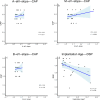Exploring the relationship between electrophysiological measures of the electrically evoked auditory brainstem response and speech perception outcomes post-cochlear implantation
- PMID: 39751634
- PMCID: PMC12122569
- DOI: 10.1007/s00405-024-09185-9
Exploring the relationship between electrophysiological measures of the electrically evoked auditory brainstem response and speech perception outcomes post-cochlear implantation
Abstract
Objectives: This study examined the relationships between electrophysiological measures of the electrically evoked auditory brainstem response (EABR) with speech perception measured in quiet after cochlear implantation (CI) to identify the ability of EABR to predict postoperative CI outcomes.
Methods: Thirty-four patients with congenital prelingual hearing loss, implanted with the same manufacturer's CI, were recruited. In each participant, the EABR was evoked at apical, middle, and basal electrode locations. The following EABR measures were analyzed: wave III and V input/output (I/O) function, latency, threshold, threshold0.5 μV and Gibson scoring. Patients' speech perception abilities were assessed using the Mandarin Speech Perception (MSP) materials presented in quiet. The Categories of Auditory Performance (CAP) and Speech Intelligibility Rating (SIR) were also used to assess CI outcomes. A regression model was developed to explore the relationship between EABR and each speech measure, to identify parameters with significant predictive ability.
Results: A significantly shorter eV latency, lower eV threshold, lower eV threshold0.5 μV and steeper I/O slopes for both eV and eIII were observed when these responses were evoked at the apical electrode, compared to the middle and basal positions. Implantation age was significantly negatively correlated with bisyllables recognition rate (R2 = 0.20, p = 0.0194). The eIII slope at the apical site and the eV slope at the basal site demonstrated the highest R2 values in positive correlation with CAP, both with R2 = 0.09. Among the EABR parameters, the regression models based on MSP bisyllables recognition rate, basal eV latency, eV thresholds and threshold0.5 μV recorded at the apical and middle positions were statistically significant.
Conclusions: Our study identified an apex-to-base gradient in EABR responsiveness following prolonged CI use. The threshold and I/O slopes of EABR appear to be informative predictors of speech perception performance in CI users, especially in the low-to-middle frequency range. However, further validation is needed.
Keywords: Auditory performance; EABR (electrically evoked auditory brainstem responses); I/O slope (amplitude growth function); Speech perception; Threshold.
© 2024. The Author(s).
Conflict of interest statement
Declarations. Conflict of interest: The authors declare that they have no competing interests. The authors alone are responsible for the content and writing of this paper. Ethics approval and consent to participate: The study was supported by National High Level Hospital Clinical Research Funding (Grant No: 2024-NHLHCRF-PYII-03; 2023-NHLHCRF-PY-02). All procedures performed in studies involving human participants were in accordance with the ethical standards of the China-Japan Friendship Hospital Ethical Committee. Informed consent was obtained from all individual participants involved in the study. Consent for publication: Consents for publication were obtained from all participants.
Figures




References
-
- Tyler RS, Kelsay DM, Teagle HF, Rubinstein JT, Gantz BJ, Christ AM (2000) 7-year speech perception results and the effects of age, residual hearing and preimplant speech perception in prelingually deaf children using the Nucleus and Clarion cochlear implants. Adv Otorhinolaryngol 57:305–310 - PubMed
-
- Illg A, Haack M, Lesinski-Schiedat A, Buchner A, Lenarz T (2017) Long-term outcomes, education, and occupational level in cochlear implant recipients who were implanted in childhood. Ear Hear 38(5):577–587 - PubMed
-
- Koch DB, Osberger MJ, Segel P, Kessler D (2004) HiResolution and conventional sound processing in the HiResolution bionic ear: using appropriate outcome measures to assess speech recognition ability. Audiol Neurootol 9(4):214–223 - PubMed
-
- Geers AE (2004) Speech, language, and reading skills after early cochlear implantation. Arch Otolaryngol 130(5):634–638 - PubMed
MeSH terms
Grants and funding
LinkOut - more resources
Full Text Sources
Research Materials
Miscellaneous

